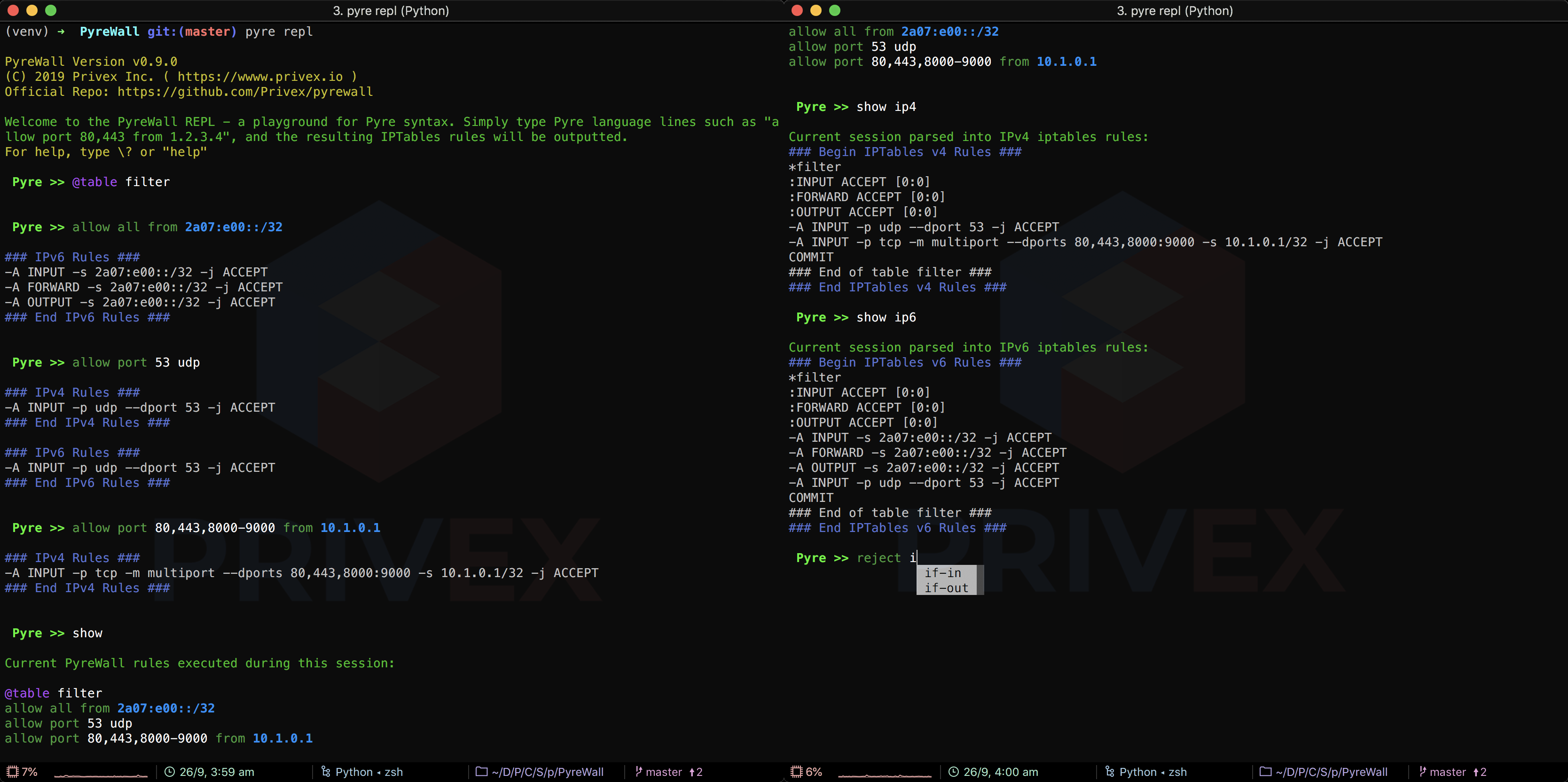一个易于管理的iptables防火墙的Python工具/服务
项目描述
Privex Pyrewall
Python中的iptables防火墙管理系统。
警告:仍在建设中
+===================================================+
| © 2019 Privex Inc. |
| https://www.privex.io |
+===================================================+
| |
| PyreWall - Python iptables firewall tool |
| License: X11/MIT |
| |
| Core Developer(s): |
| |
| (+) Chris (@someguy123) [Privex] |
| |
+===================================================+
PyreWall - A Python tool / service for managing iptables firewalls with ease
Copyright (c) 2019 Privex Inc. ( https://www.privex.io )
安装
Pyrewall可以从PyPi轻松安装,使用标准的pip3包管理器。
# Install/Upgrade Pyrewall using pip3 as root
sudo -H pip3 install -U pyrewall
建议您创建/etc/pyrewall,并附带一个“主规则文件”rules.pyre。
sudo mkdir /etc/pyrewall
sudo touch /etc/pyrewall/rules.pyre
注意:如果您不喜欢rules.pyre的名称,您的主规则文件可以命名为以下名称之一(这些名称将按顺序尝试)
- rules.pyre
- main.pyre
- master.pyre
- base.pyre
- firewall.pyre
警告:如果您同时有rules.pyre和firewall.pyre等,则rules.pyre将具有优先级,并且除非您在调用pyre时手动指定,否则将不会使用firewall.pyre。
如果您希望Pyrewall在启动时自动加载防火墙规则,系统服务文件包含一个自动安装命令,已内置到pyre中
sudo pyre install_service
用法
安装Pyrewall(包括服务)后,您可以将Pyre规则添加到/etc/pyrewall/rules.pyre(或您决定的替代主文件名)。
要从主文件加载规则,您可以简单地运行pyre load。除非您指定-n,否则在规则加载后使用“死男人的开关”确认提示,询问您是否可以继续访问服务器且没有将自己锁在外面。
pyre load
如果您在15秒内(可以用--timeout调整)没有回应,Pyrewall将恢复运行pyre load之前的IPv4 + IPv6规则
您还可以从单个文件中加载规则(它们将替换您现有的规则)
pyre load somefile.pyre
如果您不希望Pyrewall为您应用规则,您可以使用parse命令解析Pyre文件,并输出IPv4 / IPv6 iptables规则,您可以使用iptables-restore / ip6tables-restore手动应用,或者使用像netfilter-persistent这样的自动加载系统
pyre parse --output4 /etc/iptables/rules.v4 --output6 /etc/iptables/rules.v6 my_rules.pyre
# Alternatively, you can use UNIX stdin and stdout for reading in Pyre files, and outputting the generated iptables
# rules through pipes and redirects.
pyre parse -i 4 my_rules.pyre > rules.v4
pyre parse -i 6 my_rules.pyre > rules.v6
cat my_rules.pyre | pyre parse -i 4 | sudo tee /etc/iptables/rules.v4
基本Pyre文件
以下是示例Pyre规则文件,展示了常见的规则语法,以及特殊的解释器功能,如@chain、@table和@import
# This line isn't needed, it's just here to show the syntax. The default table is 'filter' anyway.
@table filter
# By default, INPUT, FORWARD, and OUTPUT are set to ACCEPT, just like standard iptables.
# Using @chain we can change them to DROP or REJECT.
@chain INPUT DROP
@chain FORWARD DROP
# We recommend using the included 'sane.pyre' template, which handles things you'd usually copy/paste, such as
# allowing related/established connections, accepting ICMPv4 and certain ICMPv6 types, allowing loopback
# (localhost) traffic etc.
@import templates/sane.pyre
# You can specify multiple chains on one line, and also mix/match IPv4 and IPv6 addresses + subnets.
allow chain input,forward state new from 1.2.3.4,2a07:e02:123::/64
# This is equivalent to 3 ACCEPT rules (INPUT,FORWARD,OUTPUT) for each of the below subnets.
# You can put the IPs on the same line, comma separated, or put them on a separate line if you prefer.
allow all from 185.130.44.0/27
allow all from 2a07:e00::/32
# This allows port 80, 443, and 8000 to 9000 incoming - for both TCP and UDP.
allow port 80,443,8000-9000
# You can import additional .pyre files, along with standard iptables .v4 and .v6 files
# They'll be searched for within (in order):
# (current_work_dir) /etc/pyrewall /usr/local/etc/pyrewall ~/.pyrewall
# (root_of_project) (root_of_package)
@import example/other.pyre
# Reject INPUT, FORWARD and OUTPUT from this IPv4 address
reject from 12.34.56.78
rem By using 'rem', we can also write comments that will be converted into standard '#' comments
rem when the Pyre file is exported to ip(6)tables-save format.
drop forward from 3.4.5.6,2001:def::/64
# Allow port 9090 + 1010 via TCP and UDP from the specified IPv4 and IPv6 address
allow port 9090,1010 both from 10.0.0.1,2a07:e01::/32
# This is equivalent to:
# -A INPUT -p tcp -m multiport --dports 99,88 -m multiport --sports 10,20 -j ACCEPT
allow port 99,88 sport 10,20
# Allow UDP traffic where the source port is between 1000 and 2000
allow sport 1000-2000 udp
使用REPL
(注意:上面的动画GIF演示大约为110MB,根据您的互联网速度可能需要一段时间才能加载。您也可以在我们的YouTube视频中查看原始速度、全质量演示)
Pyrewall附带一个REPL(读取评估打印循环),这是一个用于实验Pyre语言的交互式提示。它支持箭头键(您可以按上/下键访问历史记录,并使用自动补全),具有语法建议的自动补全,以及您在键入时实时语法高亮显示
这与Python(python3 -i)和PHP(php -i)等编程语言的交互式解释器类似。
安装Pyrewall后,只需键入pyre repl,您就会进入REPL。
pyre repl
您可以键入\?或help来显示REPL功能的使用帮助以及您可以尝试的一些Pyre示例行。
您还可以使用.pyre文件加载REPL,允许您以语法高亮显示打印文件,向其中追加新行,并将其编译为IPv4 / IPv6 iptables规则
# Load the REPL with the included templates/sane.pyre pre-loaded into the REPL history
pyre repl templates/sane.pyre
打印当前会话期间输入的规则(包括在CLI上指定文件时加载的规则)
# Show the Pyre rules entered during this session, with syntax highlighting
\show
# Compile the IPv4 Pyre rules into IPv4 iptables format and print them
\show ip4
# Compile the IPv6 Pyre rules into IPv6 iptables format and print them
\show ip6
# Print both IPv4 + IPv6 iptables rules
\show both
# Print Pyre rules, as well as IPv4 + IPv6 rules
\show all
将REPL会话中的规则输出到文件
# Output the Pyre rules into a Pyre file
\output pyre my_rules.pyre
# Convert the Pyre rules into IPv4 iptables format and output them into a file for use with iptables-restore
\output ip4 ipt_rules.v4
# Convert the Pyre rules into IPv6 iptables format and output them into a file for use with ip6tables-restore
\output ip6 ipt_rules.v6
项目详情
下载文件
下载适用于您平台的文件。如果您不确定选择哪一个,请了解更多关于安装包的信息。
源代码分发
构建分发
pyrewall-0.12.0.tar.gz的哈希
| 算法 | 哈希摘要 | |
|---|---|---|
| SHA256 | 03fa4ad2e4e3791a6dfba5b94ab71a1cd3e7cf75c483db0d5689d8bc2f7b0670 |
|
| MD5 | ee54aa2449700ce977df69a6d1d0819b |
|
| BLAKE2b-256 | c242154275b34f12763c54e0d6abaae58b23ebb2ac7a5ce81dcddc3a64d9b048 |
pyrewall-0.12.0-py3-none-any.whl的哈希
| 算法 | 哈希摘要 | |
|---|---|---|
| SHA256 | e628b528c930b49e3c76dc6284d31b0c69de999149411a5e171957d6bb51c8c1 |
|
| MD5 | fc27ce3d2683c0fcbe5074fdb59a63fe |
|
| BLAKE2b-256 | 8e6ed76fb98c09bb8df88e291077b037b82fe19598f156af150531e4119e4785 |












